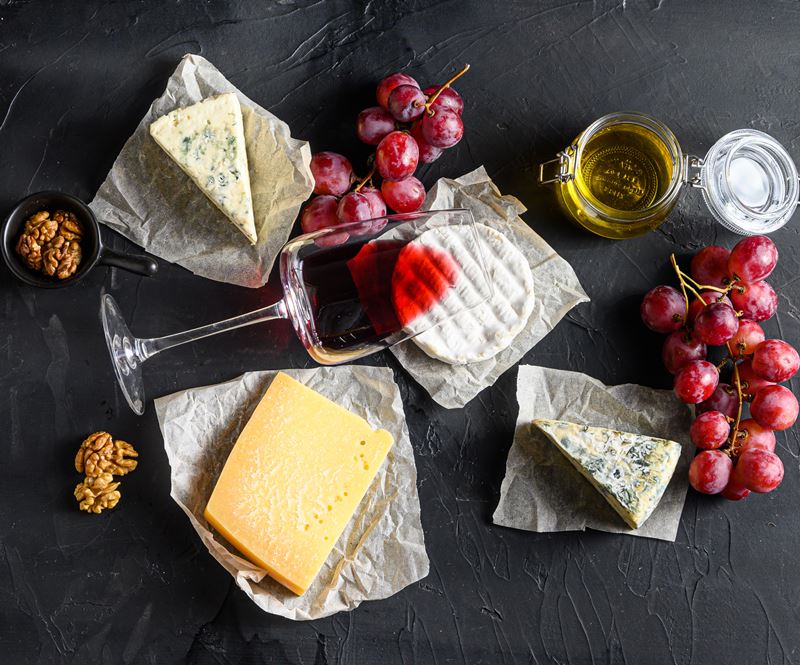The Perfect Match: Wine and Cheese Pairings
A beginner's guide to cheese and wine pairings
2024-02-27

When it comes to the art of pairing wine with cheese, it's akin to finding the perfect dance partners in a ballroom filled with flavors, aromas, and textures. It's a delightful journey through sensory experiences that can elevate a simple gathering to an unforgettable event. Whether you're a connoisseur or a curious newbie, understanding the harmony between cheese and wine can transform your dining experience into a symphony of taste.
The Basics of Pairing
The fundamental principle behind pairing wine with cheese is balance. The goal is to match the intensity of the wine with that of the cheese, ensuring that neither overwhelms the other. A robust, full-bodied wine pairs splendidly with a cheese of similar vigor, while a light, delicate wine complements a milder cheese. This harmony of intensities allows both the wine and the cheese to shine without one overshadowing the other.
A Guide to Pairing
Let's dive into some classic pairings, exploring how different types of wine interact with various cheese families.
1. Fresh Cheeses and Light White Wines
Fresh cheeses, such as mozzarella, ricotta, or goat cheese, boast a soft texture and a mild, slightly tangy flavor. These cheeses pair wonderfully with light white wines like Sauvignon Blanc or a crisp Pinot Grigio. The acidity and freshness of the wine complement the creaminess of the cheese, creating a balanced and refreshing taste experience.
2. Aged Cheeses and Full-Bodied Whites or Light Reds
Aged cheeses, such as cheddar, Gouda, or Parmigiano-Reggiano, have a more pronounced flavor and a firmer texture. These cheeses demand wines with a bit more body and character. A buttery Chardonnay or a light-bodied Pinot Noir can stand up to the intensity of aged cheeses, providing a harmonious blend of flavors.
3. Blue Cheeses and Sweet Dessert Wines
The bold and pungent flavors of blue cheeses like Roquefort, Gorgonzola, or Stilton are perfectly balanced by the sweetness of dessert wines. A classic pairing is Stilton with Port, where the sweetness of the wine cuts through the saltiness of the cheese, creating a decadent and luxurious taste sensation.
4. Hard Cheeses and Bold Reds
Hard cheeses, such as aged Parmesan or Manchego, have a dense texture and rich, nutty flavors. These cheeses can handle the robustness of bold red wines like Cabernet Sauvignon, Zinfandel, or Tempranillo. The tannins in the wine interact beautifully with the fat in the cheese, resulting in a smooth and satisfying mouthfeel.
Experiment and Explore
While these guidelines provide a starting point, the beauty of cheese and wine pairing lies in experimentation. Each cheese and wine has its own unique profile, and their interactions can yield surprising and delightful results. Don't be afraid to mix and match, try new combinations, and discover your personal favorites.
Hosting Your Own Tasting
Organizing a cheese and wine tasting is a fantastic way to explore these pairings with friends and family. Offer a selection of cheeses and wines, following the basic pairing principles, and encourage your guests to try different combinations. Provide notes on the characteristics of each cheese and wine to facilitate discussion and enhance the tasting experience.
Embracing the art of pairing wine with cheese opens up a world of culinary adventures. Whether you're enjoying a casual night in or hosting an elegant dinner party, these pairings can elevate any occasion. So uncork that bottle, slice up some cheese, and let the dance of flavors begin.
Founded in 2007, Vinetur® is a registered trademark of VGSC S.L. with a long history in the wine industry.
VGSC, S.L. with VAT number B70255591 is a spanish company legally registered in the Commercial Register of the city of Santiago de Compostela, with registration number: Bulletin 181, Reference 356049 in Volume 13, Page 107, Section 6, Sheet 45028, Entry 2.
Email: [email protected]
Headquarters and offices located in Vilagarcia de Arousa, Spain.